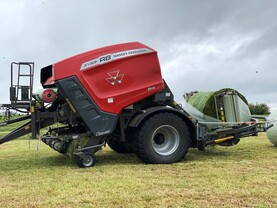Two things were apparent after a farm walk in Sligo on Thursday. Firstly, the west coast is not at a disadvantage to the rest of Ireland when it comes to growing grass. Secondly, if the will is there and the infrastructure is in place the vast majority of this grass can be utilised by milking cows.
The Dunphy family of parents Helen and Joseph along with sons Joseph and Michael are farming in Easkey, Co Sligo. The two sons have recently graduated with Dairy Business Degrees and are working off-farm, but are still heavily involved in the farm while Helen and Joseph senior are full-time.
Their farm overlooks the Atlantic Ocean. Next stop Newfoundland.
Four years ago they got the opportunity to increase the size of their farm by renting an additional 40 hectares across the road. This year, they will milk 260 cows on the 120 hectare milking block.
“A few years ago when I was milking 100 cows on my own I felt I was so busy I couldn’t imagine how we could ever expand without killing ourselves. But we put a good plan in place and thankfully everything has slotted into place,” Joseph senior explained.
Breeding
Crossbreeding with Jerseys to breed an easier care cow was part of this plan, but the biggest change has been in the use and management of grass. This is really the Dunphy’s passion.
Their farm was chosen for one of the Teagasc spring grass walks and a crowd of about 100 people attended, bolstered by agriculture students from Letterkenny IT.
In Sligo today for @teagasc spring grass walk on Dunphy farm. Report online later in @farmersjournal pic.twitter.com/tSuvmfAcO0
— Aidan Brennan (@aibrenn) 2 February 2017
Opening average farm cover is 1,003kg/ha. The stocking rate on the milking platform is 2.7 cows/ha. There are 17 cows calved so far. The plan is to turn out cows to grass at the weekend. The Dunphy farm is dry and free draining, but a few fields are wet.
Last spring, they managed to get cows out to grass every day with the exception of two, as it was just too wet.
Joseph Junior spread 25 units/acre of urea across the farm on 20 January. This was the earliest urea has ever been applied. Joseph Senior said that previously he wouldn’t have spread urea until after St Patricks Day, but then he brought this forward to the 1 March and then February.
Grazing
On/off grazing is used extensively to assist in getting grass into cows. If silage needs to be fed it is fed in the shed at night, but only enough to make sure that cows are hungry when they go out in the morning. Cows are kept back after milking for an hour if necessary to make sure they have an appetite.
“We milk at 6.30 in the morning and 3.30 in the evening. This is critically important all year. By milking early it means that we are finished up for 5pm. In the springtime we get the tea and have a break and then if necessary we can go back out at 7.30 or 8pm and bring in the cows for the night,” Joseph said.
Grass is allocated in 12-hour breaks and a back fence is used. Cows will be fed 2 to 3kg of meal in the spring and baled silage if needed.
The Dunphy’s are assisted by Paul Conway, who works on the farm part-time, mostly doing evening milkings and also by a student in spring.






 This is a subscriber-only article
This is a subscriber-only article











SHARING OPTIONS: